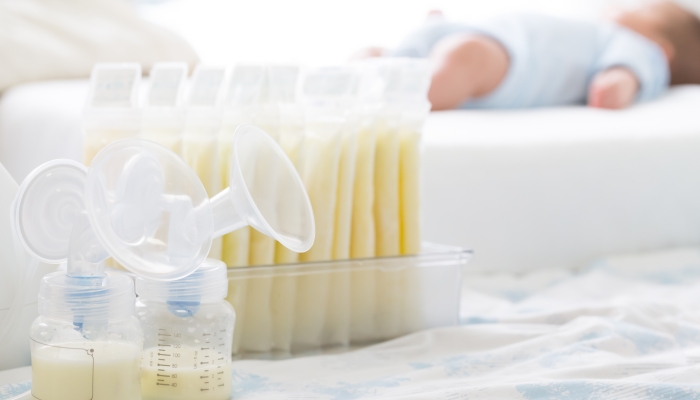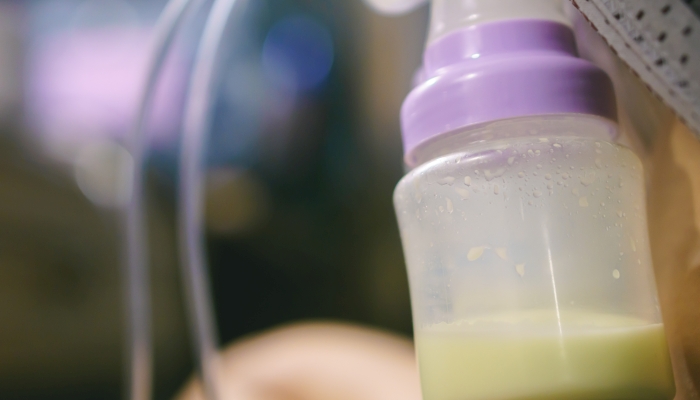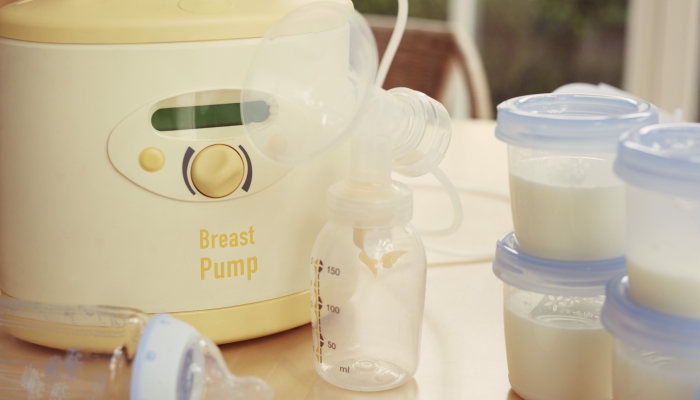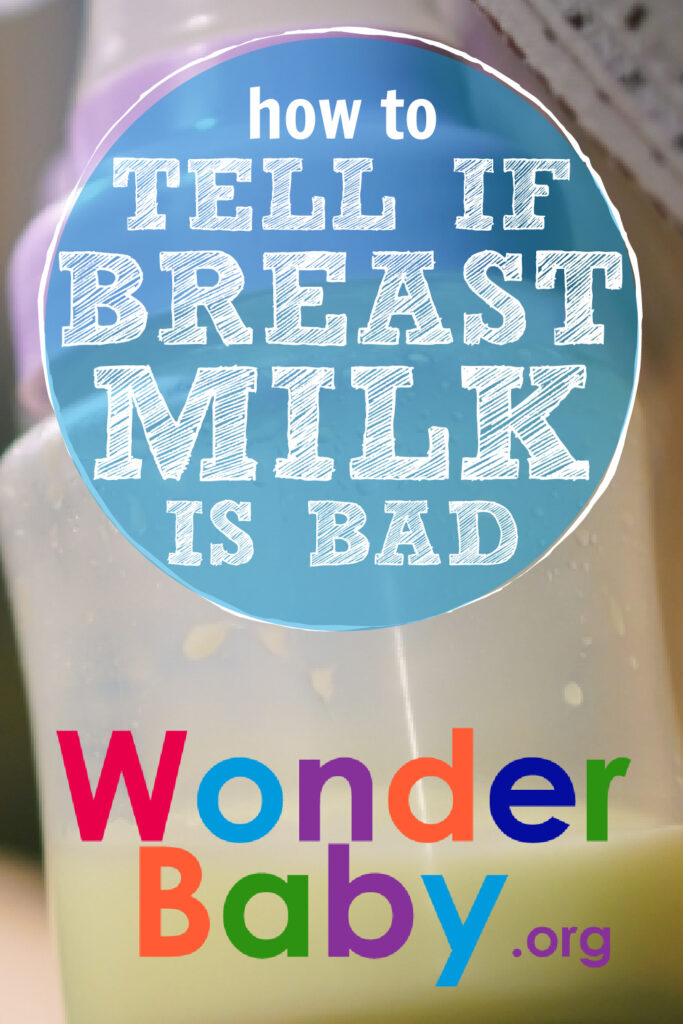How to Tell if Breast Milk Is Bad

- Normal breast milk can vary in color and normally smells and tastes sweet.
- Spoiled breast milk can look clumpy and will smell and taste sour.
- Prevent spoiled milk by washing hands and keeping pump parts clean.
- Follow safe storage recommendations for breast milk.
Being able to pump milk allows mothers to spend longer periods away from their babies. If you need to return to work or just take a few hours for yourself, it’s great to be able to leave some breast milk at home for your baby.
Storing milk in a fridge or freezer works great, but is important to be aware of milk spoilage.
Pumped milk can change color and consistency from day to day. Just like any other milk, it can go bad if left out too long. You would never want to give your baby spoiled milk. At the same time, pumped milk is like liquid gold, and you would never want to throw away stored breast milk if you don’t have to.
Breast milk has all different colors, smells, and tastes. It can change depending on what you eat and what your baby needs. Because breast milk can change so often, you’ll need to know how to tell if breast milk is bad.
Soapy or Metallic Breast Milk: Is It Safe?
Soapy or metallic breast milk can be caused by many different things. The taste or smell isn’t necessarily dangerous for your baby. Finding the root cause of smelly or off-tasting milk will determine whether or not it is safe.
Some mothers produce more lipase than others. This can cause a soapy taste and smell. Lipase activity increases as expressed milk sits out at room temperature. This excess lipase can cause changes in taste and smell even when the breast milk is still fine to drink.
Metallic breast milk is caused by chemical oxidation. This can happen even when milk is stored properly. It is thought to be caused by the mother’s diet. Eating too many polyunsaturated fats or drinking water with iron ions and free copper causes chemical oxidation.
What to do about a soapy smell and taste
If your baby refuses soapy-tasting milk, you can scald the milk before storing it.
If your milk changes taste due to lipase, scalding will fix the problem. If your milk changes taste due to chemical oxidation, scalding will make the problem worse.
Scalding breast milk is an easy process. Simply heat freshly expressed breastmilk over the stove until it reaches about 180 degrees Fahrenheit. It should bubble but not come to a rolling boil. Then immediately put your milk in the refrigerator or freezer for storage.
If your baby does not mind the soapy taste, do not scald your milk. Scalding breast milk removes some of the immunological components of breast milk that benefit your baby.

The Appearance Test
Normal appearance of breast milk
It is completely normal for expressed breast milk to separate when stored in the refrigerator. The fatty part will float to the top and the watery part will sink to the bottom.
Watery breast milk is not a problem unless your baby starts having digestive problems.
Human milk is usually white with a blue or yellow tint. Eating a lot of green foods can turn your breast milk green. Blood from cracked nipples may turn your milk pink or brown. None of these colors are cause for concern.
Bubbly milk may be a sign of strong letdown or poor breast pump connections. Try to let bubbles settle before feeding your baby to avoid gas.
Spoiled milk appearance
Spoiled breast milk will look and act just like spoiled cow’s milk. If your milk has chunks in it, it’s time to throw it out. Even though pumped milk naturally separates, the fat and watery milk should mix together easily when swirled.
The Smell Test
Normal milk smell
Normally, breast milk does not have a strong smell. It should have a mildly sweet smell. Using a sniff test is a quick way to tell if milk has gone bad.
Just like colors, breast milk can have different smells. A soapy smell is normal and safe.
Spoiled milk smell
While normal milk usually smells mild, spoiled milk will have a strong smell. The smell of milk is one of the earliest signs breast milk has gone bad. Spoiled milk has a sour, rancid smell. The same kind of smell that cows milk has when it goes bad.
If you open a bottle or bag of breast milk and smell anything sour, do not feed it to your baby. Rancid fats in a mother’s milk can make babies sick.
The Taste Test
The taste of breast milk can change depending on what you eat. Foods with strong flavors like garlic and soy sauce change the milk flavor more than mild foods.
Breastfed babies usually become less picky eaters as toddlers because they have experienced more flavors than babies who drink formula. If you have a diet full of different flavors, your baby will too.
Normal breast milk taste
Many people agree that freshly expressed breast milk tastes like sweetened almond milk. The flavor can change slightly depending on the foods you eat.
Thawed breast milk may develop a soapy taste. This taste can get stronger depending on how long the milk sits at room temperature.
Mastitis or blocked ducts can make your breast milk taste salty. This is because your breasts swell and retain more sodium and water. Salty breast milk is fine for your baby. Your milk should return to normal a few days after the swelling resolves.
Spoiled breast milk taste
Spoiled breast milk will develop a sour taste. If your milk has gone bad, you should be able to tell from the appearance and smell of breast milk. If you are still unsure, take a small taste before feeding it to your baby.
If your milk tastes sour, it is not safe for your baby.

Storage Tips to Prevent Milk From Spoiling
There are steps you can take to prevent breast milk from spoiling. Most importantly, you have to prevent bacterial contamination and chemical oxidation. You might find this Centers for Disease Control article helpful when learning how to handle and store your milk.
Safely handling pumped breast milk
The first thing you should do before each pumping session is wash your hands. Just like you would wash your hands before preparing a meal for older family members, wash your hands before preparing a meal for your baby.
For disease control and prevention, store your pump and storage containers in a clean, dry place. A bathroom is not a great place for a pumping session. Employers are required to provide a private space for mothers to pump that is not a bathroom.
Safely storing breast milk
Safe breast milk storage is crucial for protecting your baby from harmful bacteria. If you are away from home, make sure you bring an insulated cooler bag with ice packs to use right after your pumping sessions.
You might also want to get a small refrigerator to keep your milk safe if you work away from home. Milk is okay at room temperature for about four hours, but the sooner you can store breast milk, the safer it will be.
To avoid milk spoiling, follow these 10 tips:
- Cool freshly expressed milk right away.
- Label your milk with the date it was expressed.
- Store milk near the back of the refrigerator.
- Never store milk in the refrigerator door.
- Do not keep milk in the refrigerator longer than 6 days.
- Use storage bags or a storage bottle designed for breast milk.
- Keep older milk in the front of the freezer where it will be used first.
- Avoid bubbles in frozen milk.
- Do not keep milk in the freezer longer than 6 months.
- Be cautious when trying to refreeze thawed breast milk.
Cleaning your breast pump
Clean your breast pump and let it air dry between each use. If you are at work, try to have a designated place for washing pump parts. For cleaning your pump at work, you will need to bring:
- A basin
- A scrubbing brush
- Mild dish soap
- Labels or a marker
Each time you pump, wash your pump parts in your basin from home in hot, soapy water. Rinse them well and let them air dry. Make sure you label your milk right away.
You can put the pump parts in the dishwasher or boiling water when you get home to sanitize them. La Leche League recommends sanitizing pump parts once a day for infants under three months old.
FAQs
What are some surprising uses of expired breast milk?
Unfortunately, when breast milk has gone bad, there is not much to do with it. However, if you find frozen breast milk at the bottom of your freezer, don’t throw it out right away. If the milk has been in a freezer for longer than six months, you shouldn’t feed it to your baby. There are other uses for expired thawed milk.
As long as the milk doesn’t smell rancid, you can add breast milk to your baby’s bathwater. This can help their skin feel extra soft. You can also make breast milk lotion or soap with old milk.
Breast milk baths, soaps, and lotions help with several skin conditions. You can use it on your baby or yourself. It can help with eczema, cradle cap, diaper rash, and acne.
Can breast milk get spoiled while it’s inside your breasts?
Milk does not spoil while it’s inside your breasts. Milk is perfectly preserved inside the human body. If you wait too long to breastfeed, you will probably start to feel full and sore, but your milk will never go bad.
What will happen if my baby drinks spoiled milk?
If your baby drinks breast milk that has gone bad, they will most likely vomit it back up. They may cry and have an upset stomach for a few hours. Generally, your baby will be uncomfortable but fine.
On rare occasions, spoiled milk can give your baby diarrhea or a fever. If this happens, you should immediately take your doctor to see a medical professional.
Can I donate milk that’s about to expire?
Some mothers who make excess milk wonder about donation. Donating breast milk is a fantastic way to help other moms and babies.
If you think you will have extra milk in the future, sign up early to be a donor. Unfortunately, you can not just take any frozen breast milk and drop it off. The milk must be stored in special containers and you have to sign up beforehand.

The information WonderBaby provides is not intended to be, and does not constitute, medical or other health advice or diagnosis and should not be used as such. Always consult with a qualified medical professional about your specific circumstances.
Related Posts

Breastfeeding, Sleep
Sleep and Breastfeeding: A Comprehensive Guide for Nursing Moms
Many people assume breastfeeding and sleep training don’t go together, but it is possible to help your baby sleep better while continuing your breastfeeding journey.

Breastfeeding
Comfort Nursing: Pros, Cons, and How to Stop
Find out what comfort nursing is, when should you worry about it, and how to stop or limit your baby's comfort nursing (especially at night!).

Breastfeeding, Product Reviews
5 Best Breastfeeding Chairs for Nursing Moms of 2023
Whether you want a gentle rock, a smooth glide, or a cozy cuddle to soothe your baby to sleep, you’ll have your pick of the best breastfeeding chairs on the...